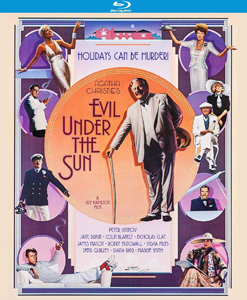Shot on the beautiful island of Majorca (now famous as the home of Rafael Nadal), featuring a stellar cast and faithfully adapting Agatha Christie’s clever whodunit plot, “Evil Under the Sun” (1982) is a sunny delight of a Poirot movie. It’s probably sacrilege, but I like it a lot more than Albert Finney’s “Murder on the Orient Express” and a tad more than Peter Ustinov’s “Death on the Nile.”
This marks the second of Ustinov’s five Poirot turns and director Guy Hamilton’s and co-writer Barry Sandler’s second Christie adaptation, following “The Mirror Crack’d” (1980).
Ustinov meets Poirot again
Though the source material isn’t as lauded as those of the previous two Ustinov films, it’s a great puzzle, rather similar to “Nile” now that I think about it. On an island small enough to take a paddleboat around, but large enough that your legs will be tired if you do (as Roddy McDowall’s Rex Brewster finds out), a vacationer is found strangled on one of the secluded beaches.

“Evil Under the Sun” (1982)
Director: Guy Hamilton
Writers: Anthony Shaffer, Barry Sandler (screenplay), Agatha Christie (novel)
Stars: Peter Ustinov, James Mason, Maggie Smith
But everyone on the island has an alibi. Even if you remember the solution from the book – nicely co-written by Anthony Shaffer, who penned three of the Ustinov Poirots, plus “Frenzy” and “The Wicker Man” – “Evil Under the Sun” is a pleasant and jaunty viewing experience.
Smoothly paced with Majorca shown off by cinematographer Christopher Challis, the film isn’t overly trivial about the notion of murder. But nor does it turn the topic into fodder for dark whimsy, like in recent films such as “Knives Out.” However, the colorful cast of characters is a draw.
Ustinov was famously (or infamously) fine with making his own version of the Belgian detective – a gregarious Ustinov-meets-Poirot, rather than a straight Poirot – but the ensemble is so good that any quibbles I had in that area disappeared.
Colorful vacation mates
Christie’s and Shaffer’s character work is respectable, but the actors elevate nearly every vacationer. Among them are Diana Rigg as Arlena, an arrogant and in-demand actress fawned over by some – including reporter Rex – and loathed by others, including stepdaughter Linda (Emily Hone, excellent as the annoyed teen despite this being one of her only two roles).
Denis Quilley is Arlena’s incongruously likeable new husband, Maggie Smith (the “Harry Potter” films) is the hotel proprietor and Arlena’s old rival from the stage, Nicholas Clay is the handsome man who is a little too friendly with Arlena, and Jane Birkin is the man’s irritated wife.

Shaffer and Sandler have them bob and weave among each other, so we learn about them even while vicariously enjoying the beach and ocean. The way they shortchange some of Christie’s threads can be questioned. The explanation for young Linda’s behavior is richer in the book. In one awkward movie scene, she lies about Rex’s whereabouts, thus making him a temporary suspect, but then tells the truth later in the same scene.
The motive for the murder is more convoluted than need be, even though Shaffer and Sandler tap into that Christie staple of a valuable jewel and a paste replica. Even though I remembered the novel’s solution, I’m not tired yet of seeing Poirot gathering everyone in a room for a long (but gripping) explanation of what happened.
This is a breezier installment than the previous two Poirot films. Shaffer and Sandler retain the book’s short Poirot monologs about how people become mere bodies when sprawled along the beach, and how evil can exist in paradise. But I can’t say “Evil Under the Sun” has much thematic resonance or the same emotional weight as “Orient” and “Nile.” However, do we really want that when on vacation?

